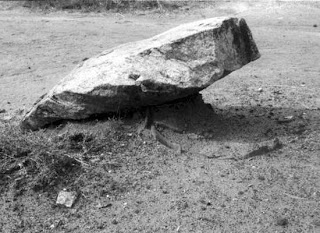Hundreds of glass beads, beads made of semi-precious stones and terracotta, fragmented bangles, pot herds with graffiti marks are some of the rare excavations made at Sengalur village in Kulathur taluk in Pudukottai district. A rare gold foil, a couple of topaz stones and nine carnelian stones are some of the important excavations at the site.
The ASI took up the excavation at the village about two months ago and excavated the rare megalithic wares of Iron Age period dating back to 2,300 to 2,500 years ago.
Addressing the media persons at the site, D. Dayalan, Superintending Archaeologist, Temple Survey Project, Southern Region, ASI, said that Sengalur was one of the major sites with hundreds of megalithic edifices of different varieties on an extent of about 20 hectares. Both burial sites and habitation sites are located in the village and obviously, the ASI took up the excavation at both the places.
Megalithic wares at burial sites
A large number of pottery wares in red and black; ring stand with pots; terracotta wares; toy objects; bowls, lids and decorative pieces made of clay have been excavated.
The special feature of the village is that it accounts for a variety of Iron Age sepulchral monuments which could be broadly classified as stone circles with or without cairn packing; stone circle with cist burial of different types; cist burial with an extension in the front; urn burials; urn burials with capstone; menhir; rectangular shaped structure.
The burial sites testify to both the engineering skill of the people of the hoary past and their glory and honour to the dead. The sites have been well designed. It is bordered by an array of locally available laterite blocks of uniform size and shape. The presence of granite slab stones at the megalithic monuments indicates to the availability of the granite at a nearby village. At the bottom of the granite boulder, the ancient people had carved out a semi-circular shaped passage through which the objects used by the dead had been kept. “At least 300 burials have been found in this place, a rare feature in the entire South India,” says Dr. Dayalan.
On the objectives of the excavation, he said that the sepulchral monuments formed the foundation of all architectural edifices and hence a study of these earlier monuments would provide ample evidence to analyse the early architectural style, the mode of their execution, human resource management, equipment used so on and so forth. Among the megalithic burial sites, the rectangular structure was found only in Sengalur and Sittannavasal villages in Pudukottai district.
Excavation at habitation site
The study on habitation sites of Melapatti and Nathakadu villages in the vicinity has resulted in the excavation of many terracotta figurines, scores of glass beads, beads made of semi precious stone and terracotta, fragmented bangles, potsherds with graffiti markings.
The availability of a glass tube testified to the fact that the ancient people were good at making the glass beads and bangles. Another habitation site testified to the extraction of iron from the iron ore.
The Assistant Archaeologist, A. Anilkumar, said that steps were being taken to create awareness among the masses, especially school students on the importance of the megalithic wares. The excavated sites had been re-filled with earth, after documentation and digital photographing.
The village is 36 km from Tiruchi.
http://www.ifpindia.org/histatlas/Atlas_Files/pudukottai.html
http://www.thehindu.com/news/cities/Tiruchirapalli/ancient-megalithic-wares-excavated-near-pudukottai/article566336.ece
http://www.newindianexpress.com/states/tamil_nadu/article203623.ece














No comments:
Post a Comment